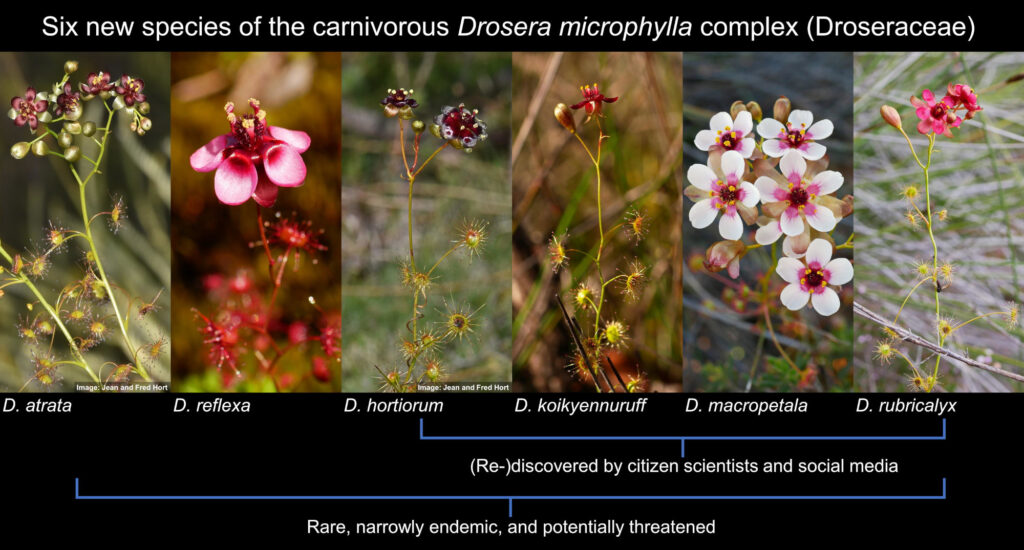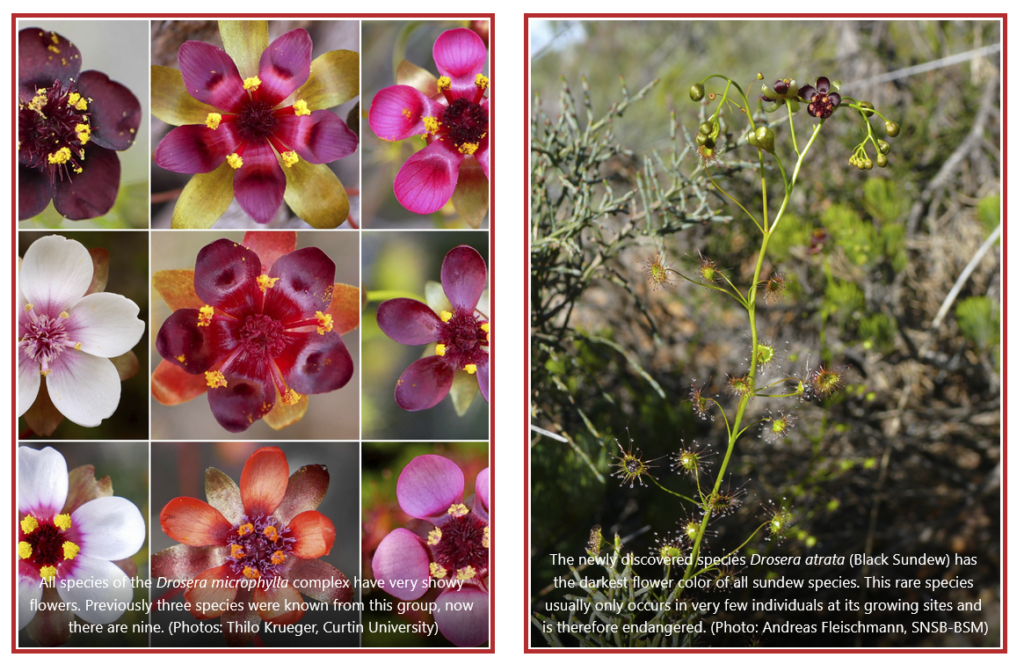Citizen Science: Social media helps discover new plant species
An Australian-German research team led by SNSB botanist Andreas Fleischmann has discovered six new carnivorous sundew species from Western Australia. Actually nothing special for botanists – however, four of the six new species were identified from photos posted on social media channels by nature photographers. The researchers have now published the results of their investigations and the description of the new species in the renowned journal Biology.
Although we are currently in a period of global species extinction in the 21st century, scientists are constantly discovering new animal and plant species. It’s a race against time – without the intensive work of species researchers, many creatures would become extinct without ever having been known before. Now, a group of German and Australian botanists has received surprising support in their search for new species of the carnivorous sundew (genus Drosera) in southwestern Australia: The scientists were helped by social media contributions from Australian amateur photographers who posted their plant photos on Facebook & Co. Among these photos were known sundew species from several previously unknown locations, as well as four previously completely unknown plants, which were identified by the scientists as new species. All the examined plants originate from a group of tuber-forming sundew species from Western Australia, more precisely from the relationship of the species Drosera microphylla. Two further species from this plant group were discovered by the scientists themselves during their field research in Western Australia, so that a total of six new species from the so-called Drosera microphylla species complex have now been described – in addition to the three species known so far from this relationship. Of the tuber-forming sundews themselves, there are about 80 species in Australia.
The research team led by Andreas Fleischmann of the Bavarian State Collection of Botany (SNSB-BSM) and the GeoBio-Center of Ludwig-Maximilians-Universität Munich, and doctoral candidate Thilo Krueger of Curtin University Western Australia, has now published its findings in the renowned journal Biology. Botanists from the Royal Botanic Gardens Victoria, Melbourne, and from New South Wales were also involved in the study.

(Photos: Thilo Krueger, Curtin University, Australia, Jean u. Fred Hort, Australia)
Nowadays, biologists discover new animal and plant species not only on research trips and expeditions to unknown regions, or during examinations of herbarium specimens, or preparations in natural science collections. An increasing number of new species are now being discovered by experts “online”, in photo databases or social media channels, where these new, as yet unknown species are documented intentionally or by chance by nature photographers and citizen scientists.
Carnivorous plants are also among them – for example, one of the first plant species discovered on Facebook back in 2014 was a large sundew (Drosera) from Brazil. Apparently, carnivorous plants, with their often striking appearance and bizarre-looking shape, are among the objects most often photographed by nature lovers. The number of observations by lay scientists in social media and even in scientific biodiversity databases (e.g. GBIF – Global Biodiversity Information Facility) now far exceeds the number of data from research collections. A sundew species newly described from South Africa by SNSB scientist Andreas Fleischmann in 2018 was known from three historical herbarium records at the time of its discovery, as well as from seven photos on the Citizen Science website iNaturalist already at that time. Today, just four years later, iNaturalist (as of January 2023) already contains 307 observations of this species, made by 131 nature-interested “hobbyists”. The number of known herbarium specimens of sundew from South Africa in natural science collections has meanwhile remained the same.
“The research data of the Citizen Scientists are a valuable source of data for us biodiversity researchers – and thus of great importance for the protection of many animal and plant species. In particular, we would not be able to determine the distribution ranges of very rare species without this additional wealth of data,” says Andreas Fleischmann, the study’s final author.
Publication:
Krueger, T., Robinson, A., Bourke, G. & Fleischmann, A. (2023). Small leaves, big diversity: citizen science and taxonomic revision triples species number in the carnivorous Drosera microphylla complex (D. section Ergaleium, Droseraceae). Biology 12, 141. https://doi.org/10.3390/biology12010141
Contact:
PD Dr. Andreas Fleischmann,
Botanical State Collection Munich (SNSB-BSM) & GeoBio-Center LMU
Tel: 089 17861-240, e-mail: fleischmann@snsb.de


